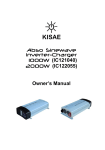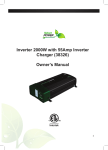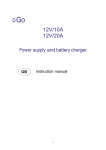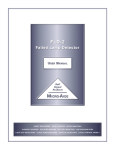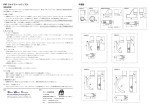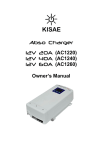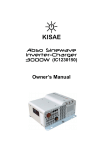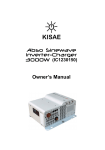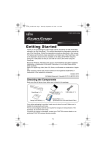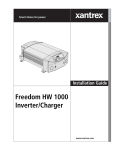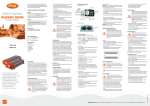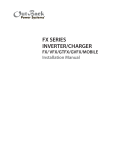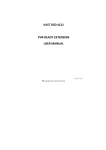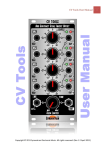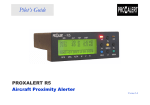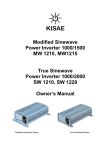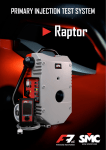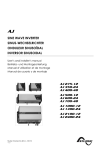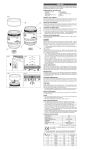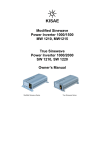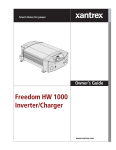Download Kisae America Car Batteries User Manual
Transcript
Abso Sinewave Inverter-Charger 1000W (IC121040) 2000W (IC122055) Owner’s Manual 1. INTRODUCTION Thank you for purchasing the KISAE Abso Sinewave Inverter-Charger. With our state of the art, easy to use design, this product will offer you reliable service by providing AC power and 5V USB power for your home, cabin, boat, RV or Trailer and recharge your battery automatically when utility AC is available. The KISAE Abso Sinewave Inverter-Charger can run many AC-powered appliances when you need AC power anywhere. The 5V USB power can charge many USBpowered devices. The multi-stage battery charger will charge different type of batteries. This manual will explain how to use this unit safely and effectively. Please read and follow these instructions and precautions carefully. IMPORTANT SAFETY INFORMATION This section contains important safety information for the KISAE Abso Sinewave InverterCharger. Each time, before using the unit, READ ALL instructions and cautionary markings on or provided with the unit, and all appropriate sections of this guide. The KISAE Abso Sinewave Inverter-Charger contains no user-serviceable parts. See Warranty section for how to handle product issues. WARNING: FIRE AND/OR CHEMICAL BURN HAZARD • Do not cover or obstruct any air vent openings and/or install in a zero-clearance compartment. WARNING: FAILURE TO FOLLOW THESE INSTRUCTIONS CAN RESULT IN DEATH OR SERIOUS INJURY • When working with electrical equipment or lead acid batteries, have someone nearby in case of an emergency. • Study and follow all the battery manufacturer’s specific precautions when installing, using and servicing the battery connected to the inverter. • Wear eye protection and gloves. • Avoid touching your eyes while using this unit. • Keep fresh water and soap on hand in the event battery acid comes in contact with eyes. If this occurs, cleanse right away with soap and water for a minimum of 15 minutes and seek medical attention. • Batteries produce explosive gases. DO NOT smoke or have an open spark or fire near the system. • Keep unit away from moist or damp areas. • Avoid dropping any metal tool or object on the battery. Doing so could create a spark or short circuit which goes through the battery or another electrical tool that may create an explosion. WARNING: Shock Hazard. Keep away from children! • Avoid moisture. Never expose unit to snow, water etc. • Unit provides 120 Vac, treat the GFCI output socket the same as regular wall AC sockets at home. WARNING: Explosion hazard! • DO NOT use the unit in the vicinity of flammable fumes or gases (such as propane tanks or large engines). • AVOID covering the ventilation openings. Always operate unit in an open area. • Prolonged contact to high heat or freezing temperatures will decrease the working life of the unit. FCC INFORMATION This equipment has been tested and found to comply with the limits for a Class B digital device, pursuant to part 15 of the FCC Rules. These limits are designed to provide reasonable protection against harmful interference in a residential installation. This equipment generate, uses and can radiate radio frequency energy and, if not installed and used in accordance with the instructions, may cause harmful interference to radio communications. However, there is no guarantee that interference will not occur in a particular installation. If this equipment does cause harmful interference to radio or television reception, which can be determined by turning the equipment off and on, the user is encouraged to try to correct the interference by one or more of the following measures: • Reorient or relocate the receiving antenna. • Increase the separation between the equipment and the receiver. • Connect the equipment into an outlet on a circuit different from that to which the receiver is connected. • Consult the dealer or an experienced radio/TV technician for help. LIMITATIONS ON USE Do not use in connection with life support systems or other medical equipment or devices. 2. PRODUCT DESCRIPTION The KISAE Sinewave Inverter-Charger includes the items list below. • Inverter-Charger base unit (one of the following models) IC121040: Abso Inverter-Charger 1000 (Sinewave Inverter 1000W with 40A charger) IC122055: Abso Inverter-Charger 2000 (Sinewave Inverter 2000W with 55A charger) • Owner’s manual (P/N: MU IC1210) 3. INSTALLATION WARNING: KISAE Technology recommends that all wiring be done by a certified technician or electrician to ensure adherence to the applicable electrical safety wiring regulations and installation codes. Failure to follow these instructions can damage the unit and could also result in personal injury or loss of life. CAUTION: Before beginning unit installation, please consider the following: • The unit should be used or stored in an indoor area away from direct sunlight, heat, moisture or conductive contaminants. • When placing the unit, allow a minimum of three inches of space around the unit for optimal ventilation. Understanding the unit features AC Output Front Panel AC Wiring Compartment: AC Output Port 1 & 2 AC Output strain relief AC Ground AC Output strain relief AC Input port USB Output Status Indicator Display On/Off button Select button AC Output Port 3 (GFCI) DC Input Rear Panel Fan opening DC Input Terminals Preparing for Installation Typical Wiring block diagram of the Power Inverter: Output: AC Output Port 1-3 & USB Inverter-Charger Input: AC Source Branch Breaker DC Disconnect Switch (IC121040, IC122055) Fuse or Circuit Breaker 12 V Battery Bank 12V Battery Bank: • The use of deep cycle battery is highly recommended for power inverter application • For battery size, you need to identify what you wish to operate, and for how long. KISAE recommends that you purchase as much battery capacity as possible. See more on Battery Run time and Load in Section 4. Fuse or Circuit Breaker: • DC-rated fuse or DC-rated circuit breaker connected along the DC positive line is required. • For IC121040 select a fuse or circuit breaker with a minimum of 150 Adc • For IC122055, select a fuse or circuit breaker with a minimum of 300 Adc • Based on the size of your 12V Battery Bank, determine the overall short circuit current rating of the battery bank from the battery manufacturer. The fuse or circuit breaker chosen has to be able to withstand the short circuit current that may be generated by the battery bank Disconnect Switch: • Select a DC Disconnect Switch with the same or higher rating of the selected fuse or circuit breaker. • The DC Disconnect Switch is used to disconnect the DC power between the unit and the battery bank during service, maintenance or trouble shooting. DC Input and Grounding Cable: • Use of low resistance wire is required for all the DC connections between the unit and the battery bank. • For IC121040, use minimum #2 AWG wire with maximum cable length of 5 feet. • For IC122055, use minimum #2/0 AWG wire with maximum cable length of 5 feet. Important: The unit is grounded through the ground stud of the unit located near the DC Input terminal. • For the grounding cable connected between the unit’s chassis and the earth ground, use a matching cable size as used on the DC Input Cable section. AC Input Source and Branch Breaker: • Standard AC Input wire is required for all the AC connections between the AC source & the AC Input port, and the AC Output ports to load. • A 30A branch circuit breaker is required to connect between AC Input source and unit’s AC Input port. Important: Follow the electrical and or building code when you connect the unit to any AC source. Installing the Inverter-Charger System WARNING: Electrical Shock Hazard The unit ‘On/Off’ switch does not disconnect the DC power from the battery. Use the DC Disconnect Switch or disconnect the DC input cables connection to disconnect the DC power from the battery before working on any circuits connected to the unit. Failure to follow these instructions can result in death or serious injury. Installation: • Choose an appropriate mounting location. • For indoor use, the unit can be mounted in any direction except with the DC Input panel facing downwards. • Use the mounting template below to mark the positions of the mounting screws. • Drill the 4 mounting holes and place the Inverter-Charger in position and fasten the unit to the mounting surface. Chassis Grounding Connection: DANGER: The unit chassis has to be grounded properly. Never operate the InverterCharger without proper grounding. Failure to do so will result in death or serious injury. • Connect the grounding cable’s ring terminal to the unit ground screw. • Connect the other side of the cable to the common grounding point. DC Input Connection: CAUTION: Reversing the DC Input terminal will damage the unit and it cannot be repaired. Damage caused by reverse polarity connection is not covered by the warranty. • Connect one end of the negative DC input cable to the Inverter-Charger DC negative terminal. Connect the other end of the negative DC input cable to the battery negative terminal. • Make sure the Disconnect Switch is in the OFF position. • Connect one end of the positive DC input cable to the Power Inverter DC positive terminal. Connect the other end of the positive DC input cable to one of the terminals of the Disconnect Switch. • Connect a DC input cable between the other terminal of the Disconnect Switch and one side of the terminal of the fuse holder. • Connect a DC input cable between the other terminal of the fuse holder and the battery positive terminal. • Install the selected fuse to the fuse holder. • Turn Disconnect Switch to ON position. AC Input Connections: Warning: Please double check on the location of the AC input port located inside the wiring compartment. Misconnecting to the AC output port inside the same compartment will blow the unit and may catch fire. Before making any AC Input and output connection, please be sure the AC Input Source is not energized and the DC disconnect switch is OFF. Important: A 30A branch breaker (not provided) is required to connect between the AC source and the Inverter-Charger. • Remove AC compartment cover by unscrewing the two screws located at the front of the AC compartment cover. • Connect the AC Input ‘L’ wire between the unit’s AC Input port and the branch breaker terminal. • Connect the AC Input ‘N’ wire between the unit’s AC Input port and the AC source ‘N’ terminal. AC Output Connections: CAUTION: Please be sure that the AC Input source is not energized before making any AC Input and Output connection and that the DC disconnect switch is turned OFF. The AC Output connection has three types of configurations: 1) Use of the provided GFCI AC socket for AC load: This configuration does not require AC Output installation. Plug in the AC load to the provided GFCI output socket. During the by-pass mode, the AC output is limited to 15A for 1000W model (IC121040) and 20A for 2000W model (IC122055). 2) Hardwire AC Output with GFCI protection: This configuration is for AC hardwire connection with a load that requires GFCI protection. During by-pass mode, the AC output is limited to 15A for 1000W model (IC121040) and 20A for 2000W model (IC122055). • Remove AC compartment cover located on the front panel of the unit. • Hardwire the AC load to the AC Output port 2. Please verify the ‘L’ and ‘N’ connection between the AC load and the AC Output port. 3) Hardwire AC Output without GFCI protection: This configuration is for AC hardwire connection with a load that does not require GFCI protection and maximizes the by-pass mode current to the rating of the branch breaker installed (maximum 30A). • Remove AC compartment cover located on the front panel of the unit. • Hardwire the AC load to the AC Output port 1. Please verify the ‘L’ and ‘N’ connection between the AC load and the AC Output port. Note: During Battery Power Mode, all AC output is limited to 8.3A for 1000W model (IC121040) or 16.6A for 2000W model (IC122055). Remote Display Connection: • The Remote Display on the unit is detachable. To install the remote to different location, an optional 6 pin standard RJ12 cable (not provided) is required. • Remove the 2 screws at the front of the Display Panel and remove the small RJ12 cable. • Install the optional RJ12 standard cable to your desired location. Please note polarity. • Connect one end of the RJ12 cable to the unit and the other end of the cable to the Display Panel. Please note polarity. Test the Inverter-Charger connection: • Switch DC disconnect switch to ON. • Switch the Branch circuit breaker to ON. • The LED on display will turn on. If AC input source is available, ‘Status’ LED turns green. This indicates the unit is running in by-pass mode meaning AC output is running from the AC input source. • LED located at the GFCI will also turn ON • Disconnecting the AC input source by turning OFF the 30A branch breaker will change the ‘Status’ LED on the Display to amber. • Both AC output and 5V USB are now available. • Plug in a small AC load like a 40W table lamp or small appliance to the AC socket to verify AC is available. • The unit is successfully installed and functioning properly. Test the GFCI monthly: • Use the following instruction to perform a monthly test of the GFCI to ensure the GFCI is functioning properly. • Turn unit on and plug a small AC load (e.g. 40W light bulb) to the GFCI. • Check that the AC load is ON. • Press ‘Test’ button and observe a clicking sound. Check that the AC load is turned off. • Press ‘RESET’ button and check that the AC load is back ON again. 4. UNIT OPERATION Auto Backup Mode (Factory default setting): The unit is fully automatic. When utility power is available, the unit is running in AC bypass mode. AC output is supplied from the utility. The internal AC charger is ON and will automatically top up the battery bank that is connected to the unit. When there is a power failure from the utility or an AC source is not available, the unit will run on battery power and the unit will generate sinewave AC output to maintain and operate the load continuously. Non-Backup Mode Same as Auto Backup Mode but when there is a power failure of the utility or the AC input source is not available, the inverter will not turn ON automatically. You are required to manually turn ON the inverter. Understanding the Display Function: Status LED Green (solid) Green (flashing) Amber (solid) Amber (flashing) Red (solid) Display LED Green OFF Display ‘Ful’ ‘bul’ Function/Status By-Pass Mode. Battery is fully charged By-Pass Mode. Battery charging in progress and is in ‘BULK’ mode OFF ‘abs’ By-Pass Mode. Battery charging in progress and is in ‘ABSORPTION’ mode Green ‘12.5’ Battery Mode, inverter is running, display shows battery voltage in DC volts Amber ‘0.80’ Battery Mode, inverter is running, display shows output power in kW (800W as shown) Battery Mode and AC Input is detected and AC output will switch to ByPass mode within 20 seconds OFF E01-E12 Unit has shutdown. Display shows error code (See error code reference chart below) Understanding the Power and Select push button function A beep sound will occur every time when the ‘Power’ or ‘Select’ button is trigger. ‘Power’ button function: • Turns unit On/Off. Press and hold for 1 second to turn unit ON or OFF ‘Select’ button function: • Check unit setting: Press once to check or verify unit’s present set functions Understanding the Error Code Code Condition E01 Input battery voltage is too low and unit has shutdown Corrective Action Recharge battery immediately and restart unit E02 Input battery voltage is too high and unit has shutdown E03 AC output is overloaded or short circuited and unit has shutdown Internal temperature is too high and unit has shutdown E04 E05 E06 E07 E08 E09 E10 E11 E12 Input battery voltage is low and warning occurs AC output has sensed high and is close to shutdown limit Internal temperature is high and is close to shutdown limit Not used Not used Battery Charging voltage too high Battery bad Internal transfer switch temperature is high and shutdown occurs Check battery voltage or determine if any external charger is connected to the battery bank Check load connected to the output. Reduce load and restart the unit Turn unit off and wait for 15 minutes before restarting. Check if any object has blocked the air flow of the unit Recharge battery as unit will shutdown shortly Reduce load Reduce load and check if any ventilation of the unit is blocked Check battery setting Battery did not accept charge Reduce load and check if any ventilation of the unit is blocked AC Load on Inverter Although the Power Inverter can provide high surge power up to two times the rated output power, some high surge loads like sump-pumps, heavy duty motors etc. may still trigger the inverter protection system even though the load falls within the power rating of the inverter. A higher power Inverter-Charger is required for these appliances. Estimate Run time on Load Following run times are estimates for reference, based on using different battery bank sizes. Actual run times may vary. Estimate run time on different 12V Battery Bank Size AC Load 60AH 120AH 180AH 240AH 300AH 50 W 11 hrs. 22 hrs. 33 hrs. 44 hrs. 55 hrs. 100 W 5 hrs. 11.5 hrs. 17 hrs. 23 hrs. 29 hrs. 200 W 2.5 hrs. 5 hrs. 8 hrs. 11 hrs. 13.5 hrs. 500 W 49 mins 2 hrs. 3 hrs. 4 hrs. 5 hrs. 1000 W 15 mins 49 mins 1.5 hrs. 2 hrs. 2.5 hrs. 1500 W 8 mins 27 mins 49 mins 1 hr 1.5 hrs 2000 W N.R. 15 mins 34 mins 49 mins 1 hrs 2500 W N.R. 11 mins 25 mins 37 mins 49 mins 3000 W N.R. N.R. 17 mins 27 mins 37 mins Note: N.R. - Not Recommended 5. FEATURE SETTING To understand more about the unit features, read the following section and follow the instructions to make changes to the desired setting. Default Factory Setting: In (Inverter): In1- inverter enabled in standby mode with load sense off Cu (Charger): 40A or 55A – charger enabled (40A for IC121040 and 55A for IC122055) AL (Alarm): AL1 – alarm enabled Sd (UV shutdown): SdL – Under voltage shutdown set to low setting bAt (Battery type): FLo – Flooded typed Cb (Maximum current): Cb3 – Maximum Shore Power Current draw is 30A Understanding the Unit Settings Inverter Setting In0 In1 In2 5A – 40A 5A – 55A FLo GEL AG Fi SdL SdH Inverter is disabled, unit will not provide backup function when utility power is not available Inverter is set to standby mode with power save mode OFF. Unit will provide backup function when utility power is not available Inverter is set to standby mode with power save mode ON. Unit will provide backup function only when utility power is not available AND the load connected to the output is >10W. Note: Unit will turns ON every 10 s to check on the power consumption. Charger Current Setting Bulk/Float current setting: IC121040: 5A/1.5A, 10A/2A, 20A/3A, 40A/4A IC122055: 5A/1.5A, 15A/3A, 35A/4A, 55A/6A Battery Type and Voltage Setting (Bulk/Absorption/Float) Flooded: 14.4V / 14.4V / 13.5V GEL: 14.2V / 14.2V / 13.8V AGM: 14.3V / 14.3V / 13.4V Fixed: 13.5 Vdc fixed voltage Battery Under Voltage Setting Battery under voltage setting is set to LOW (setting used for normal operation) Under voltage alarm: 11.0 Vdc Under voltage alarm recovery: 11.3 Vdc Under voltage shutdown: 10.5 Vdc Under voltage recovery: 12.0 Vdc Battery under voltage setting is set to HIGH (setting to avoid battery over discharge when connected to car start battery) Under voltage alarm: 12.1 Vdc Under voltage alarm recovery: 12.3 Vdc Under voltage shutdown: 11.8 Vdc Under voltage recovery: 12.6 Vdc Alarm Setting AL0 AL1 Cb1 Cb2 Cb3 Fault and warning audible alarm is disabled. Display panel only shows error code and audible alarm will not sound. Audible alarm will sound when fault or warning occurs. Maximum Shore Power Current Draw Setting IC121040 IC122055 AC Load current Charger AC Load Current Charger Current Current Set the maximum current draw from shore power to 15A. The maximum current draw from unit is set to match with the shore power circuit breaker rating to avoid tripping of the shore power circuit breaker during the by-pass mode. Battery charging current will automatically reduce when there is a high demand on AC load during the by-pass mode. >11Aac 5 Adc >11Aac 5 Adc >10Aac and <12Aac 10 Adc >6Aac and <11Aac 15 Adc >5Aac and <10Aac 20 Adc >1Aac and <6Aac 35 Adc <5Aac 40 Adc <1Aac 55 Adc Same as above. Set the maximum current draw from shore power is 20A >16Aac 5 Adc >16Aac 5 Adc >15Aac and <17Aac 10 Adc >11Aac and <16Aac 15 Adc >10Aac and <15Aac 20 Adc >6Aac and <11Aac 35 Adc <10Aac 40 Adc <6Aac 55 Adc Same as above. Set the maximum current draw from shore power is 30A >26Aac 5 Adc >26Aac 5 Adc >25Aac and <27Aac >20Aac and <25Aac <20Aac 10 Adc 20 Adc 40 Adc >21Aac and <26Aac >16Aac and <21Aac <16Aac 15 Adc 35 Adc 55 Adc Manufacturing Default Setting Fd Reset all settings to manufacturing default settings (40A for IC121040 or 55A for IC122055, In1, AL1, SdL, Flo, Cb3) Understanding the Charger De-rating Current: The charger current will be de-rated when the environment temperature reaches 60 °C (140 °F) or the internal temperature reaches the pre-set values. Unit De-rated Values Internal Temperature >90°C (194°F) Maximum charger will de-rated to half >95°C (203°F) Charger current reduced to 5A <85°C (185°F) Charger current recover back to set value Environment Temperature >60°C (140°F) Charger current reduced to 5A >55°C (131°F) Charger current recover back to set value Enter Function Menu for unit setting: To enter unit Function Menu, press and hold “Power” and “Select” button together for about 5 seconds until a beep is sounded. When you are in Function Menu: • Press ‘Power’ button for 1 second to toggle between different Functions Menu like ‘Cu’, ‘In’, ‘AL’, ‘Sd’, ‘bAt’, ‘Cb’ and ‘Fd’ etc. • Press ‘Select’ button for 1 second to enter Individual Function Set Menu and you can make change to the settings. • The unit will EXIT the Main Menu automatically if ‘Power’ and ‘Select’ buttons is not trigger for more than 5 seconds. When you are in Individual Function Set Menu: • Press ‘Select’ button for 1 second to toggle between different setting values. • Press ‘Select’ button for 5 seconds to set selected setting and exit to next Main Menu See more details on flow chart below. 6. TROUBLESHOOTING To troubleshoot the unit, please note the error code displayed on the main unit and review “Understanding the Error Codes” in section 4. Problem No output voltage. And Status LED is off. Symptom The unit is off No AC output. Status LED is Green No Output. Status LED is in Amber GFCI is tripped No power to unit GFCI is tripped Check error code on display Check AC Load Sense setting Solution Turn unit ON by following the instruction in Section 4 to turn unit ON Check DC fuse, Disconnect switch (if installed) and check if Branch breaker is either blown or turned OFF Check load and reset the GFCI Check load and reset the GFCI Verify the error condition and make correction AC Load connected must be below the AC Load sense setting 7. SPECIFICATIONS Note: Specifications are subject to change without notices. Specification Inverter AC Output Power AC Output Current AC Surge Power (Peak) AC Output Voltage/Frequency AC Output Waveform Nominal DC Input Voltage No Load battery draw DC Input Voltage operating range Under Voltage Alarm Under Voltage Alarm Recovery Under Voltage Shutdown Under Voltage Recovery Over Voltage Shutdown USB USB Port AC Transfer Switch Transfer Time Transfer Relay Rating AC Input Source Setting AC Output Port 1 (HW Connector) AC Output Port 2 (HW Connector, GFCI, CB) AC Output Port 3 (GFCI & CB) Display Display Panel Port Inverter Mode Charger Mode Charger Charging Voltage Range Float Voltage Range Charger Current (max) Charger Current Setting IC 121040 IC 122055 1000W 2000W 8.3A 16.6A 2000W 4000W 120 VAC / 60 Hz Sinewave (<3% THD) 12.5 VDC < 1.5 ADC 10.5 – 15.5 VDC 11.0/12.1 VDC 11.3/12.3 VDC 10.5/11.8 VDC 12.0/12.6 VDC 15.5 VDC 5V, 750 mA < 30 ms 30A 15, 20, 30A 30A 15A 15A 30A 20A 20A RJ12 Input Voltage, Output Power Status & Battery voltage 13.5 -14.4 VDC 13.4 – 13.8 VDC 40 ADC 55 ADC 5,10,20,40 5,15,35,55 Battery Type Charge Control Efficiency Safety and Environmental Conformance Agency Markings Operating Temperature Storage Temperature Relative Humidity Operating Altitude Weights and Dimensions Weights Dimensions KISAE BATTERY Gel, Flooded, AGM, Fixed Bulk/Absorption/Float >80% Conforms to UL 458 Certified to CSA C22.2 no. 107.1 cETLus 0°C to 40°C (32°F to 104°F) -20°C to 60°C (-4°F to 140°F) 5-90% noncondensing Up to 9,843ft (3000m) above sea level IC 121040: 12.5 lbs (5.7 kg) IC 122055: 14.5 lbs (6.6 kg) 9.0 x 18.8 x 4.5” ( 230 x 478 x 114 mm) CAR BATTERIES













